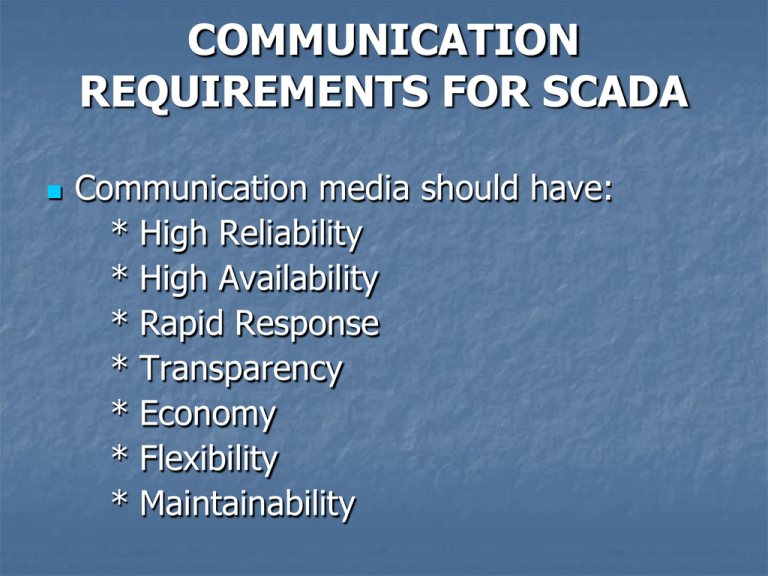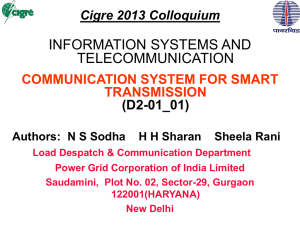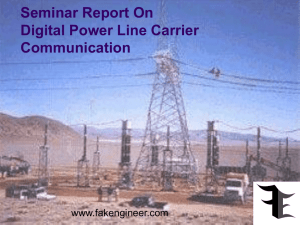COMMN
advertisement

COMMUNICATION REQUIREMENTS FOR SCADA Communication media should have: * High Reliability * High Availability * Rapid Response * Transparency * Economy * Flexibility * Maintainability Modes of Communication PLCC Leased Telephone circuits Microwave Communication Fibre Optics Communication Satellite Communication PLCC High voltage lines themselves are used as communication links. Carrier Frequency: 50-300 KHz. 3 channels are used generally: Main-Channel -> speech channel – 300 Hz to 2000 Hz Telemetring- 2000 Hz to 3400 Hz Protection-Channel-I -> speech channel – 300 Hz to 2000 Hz Teleprotection- 2000 Hz to 3400 Hz Protection-Channel-II (Backup-Protection)-> speech channel – 300 Hz to 2000 Hz Teleprotection- 2000 Hz to 3400 Hz Advantages: 1. 2. PLCC High reliability All channels are available for dedicated use by power-utility alone Disadvantages: 1. 2. 3. Cost of insulating communication equipment is high High noise level due to Corona High speed data-transfer not possible because of Bandwidth limitations. Microwave Communication Line-of-sight communication Requires repeaters at 50-60 kms. Intervals Provides sufficient bandwidth to meet the needs of power utility Higher availability than PLCC, availablity not affected by maintenance or faults on the power lines Suffers from multipath-fading effect In India, WPC (wireless planning & co-ordination) wing has assigned 2.3-2.5 GHz and 2.8-5 GHz bands to power sector usage. Digital Microwave Systems Leased Telephone Circuits •Simple solution, no need to develop own dedicated communication facility by power utility •Availability of this mode of communication at remotely located substations is the deciding factor Fiber-Optic Communication • Fiber-optic communication is a method of transmitting information from one place to another by sending light through an optical fiber. The light forms an electromagnetic carrier wave that is modulated to carry information The process of communicating using fiber-optics involves the following basic steps: Creating the optical signal using a transmitter Relaying the signal along the fiber, ensuring that the signal does not become too distorted or weak Receiving the optical signal and converting it into an electrical signal INPUT Analog/Digital Interface Voltage to Current converter Source to Fiber Interface Light Source Optical Fiber Fiber to Light Detector Interface Light Detector Current to Voltage converter Analog/Digital Interface OUTPUT Fiber Optic Communication Advantages: The ability to carry much more information and deliver it with greater fidelity than either copper wire or coaxial cable. Fiber optic cable can support much higher data rates, and at greater distances The fiber is totally immune to virtually all kinds of interference, including lightning, and will not conduct electricity. It can therefore come in direct contact with high voltage electrical equipment and power lines. POWERGRID uses overhead fiber optic communication: OPGW (optical ground wire cable) ADSS (all dielectric self supporting cable) WRAP AROUND Fibre Optic Systems INTEGRATION OF DIGITAL & ANALOG NETWORKS OPGW PLCC FODP OLTE 2 MB/S ADD DROP MUX 2 MB/S VOICE CARD DATA CARD MICROWAVE RADIO TERMINAL OPGW • • • • • • OPGW (optical ground wire) replaces shield wires Provides lightning protection Provides communication Lightning short circuit damage Installation requires long term outage Expensive Superior performance ADSS F.O ADSS (all dielectric self supporting) which is mounted at various locations, typically 3 to 10 meters below the phase conductors. ADSS costs less than OPGW Higher fiber count than Wrap type. Can be installed on towers not designed for shield wires. Suitable for hot line installation WRAP AROUND F.O Wrap-type which is wound around shield wires and, in some instances, around energized conductors Hot-line installation is difficult Cost more than ADSS, but less than OPGW Need a shield wire No operation problem is observed OVERHEAD CABLES FOR POWER UTILITIES OPGW WRAP ADSS AERIAL OPTICAL FIBRE CABLES MOISTURE BLOCKING COMPOUND AL COATED STEEL STRAND AL STRAND OPGW AD\AS\RKG\JP\FIBCROSS LOOSE TUBE POLYESTER TAPE XLPE SHEATH AL TUBE FIBRE STRENGTH MEMBERS ADSS WRAP AROUND FIBRE OPTIC CABLE INSTALLATION OPGW WRAP AROUND ADSS AD\AS\RKG\JP\FIBINST SATELLITE COMMUNICATION A geostationary satellite is used as an active repeater. Modulated signals are send from earth VSATs in 6 GHz band to the satellite. Signals are beamed back to earth in 4 GHz band. Roundtime propagation delay of 540ms exists Communication is interrupted during eclipses. Date of commissioning : January 2002 RAMAGUNDAM PEDAPALLI DURSHED JAMMIKUNTA GAJUWAKA WARANGAL VIZAG SWS SHAPURNAGAR VIDYUTH SOUDHA GHANAPUR BOMMUR KAKINADA CH.GUTTA VTPS HYDERABAD 400 BHIMADOLE N’SAGAR PH VIJAYAWADA TALLAPALLI SRISAILAM PH SRISAILAM LBPH KURNOOL APSEB Lingasugur HUBLI SOMAYAJULAPALLI RTU’S 82 N GOOTY MUDDANOOR RTPP DAVANAGERE CHINAKAMPALLY ANANTHAPUR BANGALORE KEB CHENNAI KUMBALGODI PONDY RTU’S SOMANAHALLI SRIPERUMBUDUR RTU’S P 05 SP.KOVIL 22 VILLIANUR PONDY KANNUR-B SALEM400 CENTRAL PANRUTI SALEM230 NEYVELI ERODE SECTOR RTU’S 22 CHIDAMBARAM INGUR KOZHIKODE LEGEND RSCC (1) MYLADUTURAI CPCC (1) PONGALORE UDUMALPET TRICHY TRICHUR NORTH ADANIKOTTAI CHALAKUDI MADURAI400 RTU’S 30 VIAKKAM PALLOM KAYANKULAM KUNDRA KARAIKUDI SIVAGANGA MADURAI TNEB RTU’S PARIPALLI SLDC (4) SUB-LDC / SCC (14) PUDUKOTTAI THIRUMAYAM KALAMASSERY KSEB KOVILVENNI THIRUVARUR ORTHANADU FIBRE OPTIC LINK 110/132kv FIBRE OPTIC LINK (220kv) FIBRE OPTIC LINK (400kv) FIBRE OPTIC LINK (SEB) 40 MICROWAVE LINK (35 links) TRIVANDRUM NORTH VYDYUTHI BHAVANAM SATELLITE LINK (KEB) SLDC WRTCC GOA WR-SC&C Communication system Asoj GEB Sector Kalwa Vav Asoj Mapusa Phadge Haldarwa Jambuva Boiser Vapi LEGENDS OPGW Green - ULDC Wideband Link U/G – OFC BLUE - PDT Link Leased Link Black - PLCC Link Both Main and Std. By Data PLCC Channel St. By Data PLCC Channel Main Data PLCC Channel 62 Nos. PLCC Equipment 109 Nos. Wideband ULDC Eqpt SEB’s Wideband Equipment and OFC Raigarh Seoni Sipat Vadodara POP ILA-387 Indore Gandhar Dehgam Bina-400 MPSEB Sector Indore Sub-LDC ILA-174 Itarsi Satna-220 Itarsi-220 CSEB Sector Gwalior Korba-West Bhatapara Bina Bhilai-220 Raipur ILA-362 Korba STPP ILA-311 SLDCJabalpur Satna ILA-194 Khandwa Rajgarh Korba-East CSEB Sector Bhilai-400 (SLDC) Asoj Kakrapar Kawas Bhopal-400 Sub-LDC Tarapur 3&4 Tarapur 1&2 Jabalpur-220 Ponda Borivalli Gotri SLDC Jambuva Haldarwa Katni-220 Kalwa WRLDC Jabalpur-400 V’chal ILA-368 ILA-702 Dhule Phadge Chandrapur B’Vati Raipur KR-13 Vindhyanchal Itarsi Wideband Channel Routing for Madurai Sub-LDC Peramballur Echengodu Tanjore 230 Erode Sub-LDC (Erode) Pugalur Chennai Sub-LDC (NLC TS-I) Trichy 400 Madurai North Trichy 230 Samayapuram Paramakudi Madurai Sub LDC Sivagangai Karaikudi Madurai 400 Podukotta Adanakottai C Orthonadu Kovilvenni Thiruvarur Existing RTU – 9 nos. TTPS Theni Kayathar E Sembatti Pariyar PH Sathur Tuticorin Auto Kodayar PH2 Existing RTU integrated New RTUs – 13 nos. PLCC Link S R Pudur MW Link COMMUNICATION NETWORK FOR KERALA Wideband Routing from Sub-LDC to SLDC,(Kalamassery) MW Link RSCC,Bangalore (Udumalpet) FO Link Kannur-B Kozhikode -B T. North Chalakudy Kalamassery Vidyuthi Bhavanam Trivendrum North Paripally Kundra Kayamkulam Pallom











